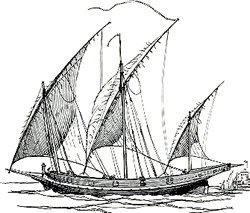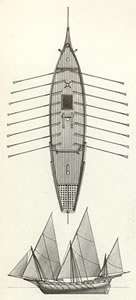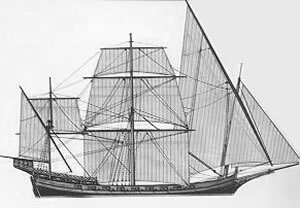|
"A song in your heart
A story to share
A dance trapped inside
An inexpressible vision
An insatiable soul
May lead you here."
Inscribed on steps of Paldan Conservatory
 |
|
|
Supplements
> Ships
|
|
 |
|
Dekàlan Orgar
|
|
|
|
|
With the exception of the continent
Tasserus and some remote islands,
the majority of the World of Teréth End can be
explored without venturing far from a coast. Due
to this reality, there was no impetus for the world's
Mortal Races to develop advanced navigation techniques
until the latter half of the Fourth Age. Much
of the required mathematics were developed much earlier
and used to a lesser extent by the Lyrasti to navigate
the Sea of Zaloo.
It was perhaps the greatest contribution by the Dekàlan
Empire to develop much of the navigational "sciences"
still in use to this day. Standard navigation,
as developed in the Old Empire by the early 8th century
HK, required the use of a sextant, a compass and an
Othic
Clock.
Waypoints. Another Dekàlan
development was the use of waypoints in conjunction
with standard nautical navigation. The waypoints
are a network of map positions on the high seas. More
important than the actual points are the avenues that
connect them. Ships that sail along these imaginary
avenues can hope to avoid treacherous currents and weather
patterns in the most volatile of regions. The
necessity for waypoints was most crucial in the Dekàlan
Sea due to the number of Tapestry frays found there.
The earliest waypoint maps date to the
late 8th century HK. Most of these scrolls are
now fragmentary, their information being so coveted
that the maps were carved and sold in pieces. Today
many of the waypoints are not used. Those ship
captains that are fortunate to know of two (or more)
hold the secret very closely. Ship merchanting
is a very competitive business and every edge one keeps
over their competitors can be counting in gold. It
is of equal interest that no Old Empire ship commandeered
during the last Acentran-Dekàlan War was found
with its maps intact. Most captains, upon the
recognition of their imminent defeat, destroyed what
was then considered a state secret.
|
|
|
|
The World of Teréth End is connected
by its ships. Ships of all kinds are found among
the world's kingdoms and continents, plying its rivers,
coasts and seas.
|
|
|
|
While other kingdoms experimented with ships
of more exotic designs and constructions, the
Old Empire never strayed far from its original
galèra
(galleys). Since the Late Empire
most galèra have been replaced with orgar
(lateen xebecs) and môrógar
(pinks), with the bol
órgar (polacre-style) being introduced
in the 12th century HK. The rivers of Panath,
Lanadus, Jadth and coasts of Azalari remain resplendent
with the smaller but colorfully sailed sar
órgar (feluccas); known along
the Run Suluth
as sorájar.
| Orgar |
 |
|
Dekàlan
Orgar
|
|
The workhorse
of the Dekàlan city-states,
the orgar are versatile ships used
for commerce, war and often a combination
of the two. The orgar are characterized
by the lateen sails (the foremast
being tilting forward, i.e. raked)
and an overhanging stern. Some
orgar had a ram attached above the
waterline of the bow to form a prow.
Old Empire statistics for the
orgar fall average:
|
Old
Empire Orgar Statistics
|
|
Length
|
90
feet |
|
Beam
|
24
feet |
|
Depth
|
10
feet |
|
Crew
|
20
(24 DC) / 25 (20 DC) / 50 (16
DC) |
|
Speed
|
10
(sail) |
|
Cargo
|
60
tons |
|
Transport
|
200 |
|
Hull
|
200
hp, 8 Hardness, Break DC 28 |
|
Deck
|
140
hp |
|
| Fast
and maneuverable, the orgar are swift
under sail and able to employ 10-20
oars when the wind dies. The orgar
of the First Acentran-Dekàlan
War were renown for being able to sail
circles around heavily laden Vulmuran
merchant ships, and easily escape Acentran
naval vessels. |
|
| Môrógar |
|
The most common merchant ship of
the Dekàlan Empire, the Môrògar
served as the workhorses of the Old
Empire for many centuries. In recent
years, some môrógar have
been replaced by the bol órgar
but there remain many harbors that
continue to use the môrógar
because they are cheaper to build
and require a smaller crews than the
bol órgar. A smaller
crew is possible due to the size of
the ship and the fewer number of sails.
Presently, the ships are most
commonly used by small merchant companies
and pirates while larger companies
and guilds employ the bol órgar.
Similar
to the orgar, the môrógar
have a more spacious hull and a less
pronounced bow and stern. Unlike
the bol órgar (see
below), all the sails of the môrógar
are lateen, again with the foremast
raked (like the orgar). Most
môrógar were smaller
ships (relative to orgar) with the
characteristic narrow stern of its
ancestor. Today, the môrógar
remains the numerous merchant ship
and can be seen in the waters near
every city-state of the Old Empire.
|
 |
|
Dekàlan
Orgar
|
|
Môrógar
Statistics
|
|
Length
|
65
feet |
|
Beam
|
17
feet |
|
Depth
|
11
feet |
|
Crew
|
6
(24 DC) / 9 (20 DC) / 12 (16 DC) |
|
Speed
|
8
(sail) |
|
Cargo
|
50
tons |
|
Transport
|
20 |
|
Hull
|
70
hp, 10 / 8 Hardness, Break DC
30 |
|
Deck
|
50
hp |
|
|
| Bol
Orgar |
 |
|
Dekàlan
Orgar
|
|
Môrógar
Statistics
|
|
Length
|
65
feet |
|
Beam
|
17
feet |
|
Depth
|
11
feet |
|
Crew
|
6
(24 DC) / 9 (20 DC) / 12 (16 DC) |
|
Speed
|
8
(sail) |
|
Cargo
|
50
tons |
|
Transport
|
20 |
|
Hull
|
70
hp, 10 / 8 Hardness, Break DC
30 |
|
Deck
|
50
hp |
|
A frigate-like
variation of the orgar used by merchants,
the bol órgar is characterized
by a more full hull and square sails
of its main and sometimes mizzenmast.
The foremast of the bol órgar
remained lateen.
The bol
órgar are believed to have
appeared in the first century DR and
were used for moving agricultural
produce between the Fertile Coast
of Kandal and Panath. The bol
órgar are therefore credited
with initiating communications between
the isolated city-states following
the Occupation.
Examples:
Aylyréar...
|
|
| Rul
Orgar |
| A preceeding
design for the bol órgar were the rul
órgar (warship) used by the Dekàlan
navy during the Second Acentran-Dekàlan
war to little avail. The rul órgar
were equipped with three to twelve bombards,
a development that would have made a much
larger difference if employed in a different
style of war. Only a handful of these
ships were ever made, and most were burned
by invading Elve armies. A single rul
órgar remains, painstakingly maintained
in fighting condition within the port of Terazya
(only a few miles north of Oddon,
where a number of the ships were originally
built). |
| Galèra |
|
The oldest of
ships used in the Old Empire, galèra
are mostly unchanged since the time of King
Anthus Terrud two millennia ago. The
Dekàlans used standard galèra
but by the late Early Empire bragàl
(biremes) began to appear across the south
seas. The Empire never developed triremes
though their use in eastern Tassèrus
was noted by Azálari scholars as
early as the third century HK.
Royal galèra
of the Late Empire were constructed without
masts. These largely featureless ships
were used to transport important goods and
persons between the city-states. The
tireless precision with which the ships
were oared led many of the time to believe
that the ships were mechanical. Their
unerring navigation of turbulent waters
and dangerous passages led still others
to surmise that their power and control
was magic. Few suspected the use of
young eárad,
the practice of intractable slavery. The
practice of using mar
eárad was abandoned in the Middle
Empire, when it was determined that no Uren
might be enslaved within the Empire without
a contract for freedom. The mar eárad
were children born on ships at sea that
were blinded at birth and used as guides
for long voyages or for safe passage through
treacherous waters. The ritual blinding
gave the children a ken for navigation.
Example: Gallerae...
|
|
|
|
| Notes
/ References |
- To Do: ...
|
|
|
|
